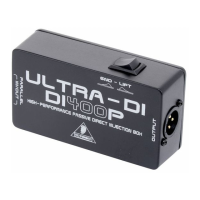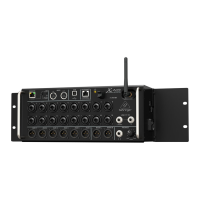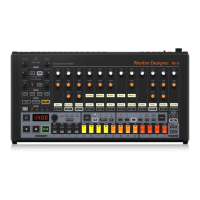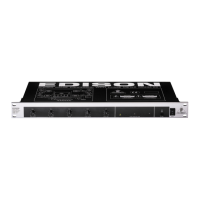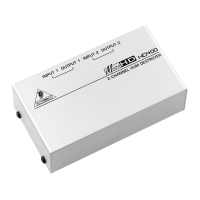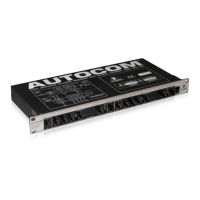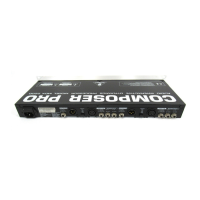7 ULTRADRIVE PRO DCX2496 User Manual
Use the buttons to the left of the output LED displays (SETUP, MUTE etc.) to enter
the various menus. Most of them include several pages, which you can select
with the PAGE buttons. The PARAM button selects individual parameters from
one page, the data wheel edits them. Conrm new settings with OK, or cancel
your selection with CANCEL. This operating structure is the same for all menus so
it will not be repeated in each section of the manual.
The menu name is shown at the top-left of the display. Next to this, andseparated
by an arrow, is the name of the current page (e.g. SETUP ➠ IN/OUT). Thepage
number of the corresponding menu is shown on the right-hand side
(e.g. 1/6 = page 1 of 6).
The bottom line also shows the menu name (e.g. SETUP). For buttons IN A-C and
OUT 1-6 (below the input/output LED displays), the menus for the corresponding
inputs/outputs are listed (IN A, OUT 3 etc.). In addition, the output display also
indicates the name of the output (e.g. SUBWOOFER, RIGHT MID etc.).
4.2 SETUP menu
Use the SETUP menu to make basic adjustments necessary for the operation
of your ULTRADRIVE PRO. Press the SETUP button to display the rst page of
thismenu.
4.2.1 IN/OUT
Fig. 4.1: Setup ➠ In/Out
The parameter OUT CONFIGURATION selects the general operating mode;
in MONO mode input A is the preset signal source for all outputs. In STEREO mode,
three congurations are available. Please use inputs A and B in these modes.
Thedisplay shows the OUT channels (L = LOW, M = MID and H = HIGH).
The stereo 3-way conguration LMHLMH has input A routed to outputs 1, 2
and 3, and input B routed to outputs 4, 5 and 6. The stereo 3-way conguration
LLMMHH routes input A to outputs 1, 3 and 5, and input B to outputs 2, 4 and 6.
The 2-way conguration LHLHLH uses all three inputs; here, A can be routed to
outputs 1 and 2, B to outputs 3 and 4, and C to outputs 5 and 6. This application is
used for 3 x 2-way speaker systems or triple bi-amping (see chapter 6.3).
Fig. 4.2: Output conguration
Fig. 4.3: Setup ➠ In/Out
With the OUT STEREOLINK function you can determine whether processing
with EQs, limiter, etc. is eective on the linked outputs, or whether the settings
for each output can be made independently. When this function is enabled (ON),
linking several outputs to each other, the display will show small connecting lines
between the individual outputs.

